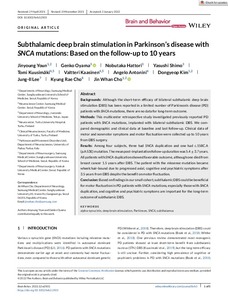Subthalamic deep brain stimulation in Parkinson's disease with SNCA mutations: Based on the follow-up to 10 years
Kaasinen Valtteri; Hattori Nobutaka; Kim Dongyeop; Cho Jin Whan; Oyama Genko; Shimo Yasushi; Lee Jung-Il; Antonini Angelo; Youn Jinyoung; Kuusimäki Tomi; Cho Kyung Rae
https://urn.fi/URN:NBN:fi-fe2022081154232
Tiivistelmä
Backgrounds: Although the short-term efficacy of bilateral subthalamic deep brain stimulation (DBS) has been reported in a limited number of Parkinson's disease (PD) patients with SNCA mutations, there are no data for long-term outcome.
Methods: This multicenter retrospective study investigated previously reported PD patients with SNCA mutations, implanted with bilateral subthalamic DBS. We compared demographic and clinical data at baseline and last follow-up. Clinical data of motor and nonmotor symptoms and motor fluctuation were collected up to 10 years from DBS surgery.
Results: Among four subjects, three had SNCA duplication and one had c.158C.A (p.A53E) mutation. The mean post-implantation follow-up duration was 5.4 +/- 3.7 years. All patients with SNCA duplication showed favorable outcome, although one died from breast cancer 1.5 years after DBS. The patient with the missense mutation became wheelchair-bound due to progressed axial, cognitive and psychiatric symptoms after 3.5 years from DBS despite the benefit on motor fluctuation.
Conclusion: Based on findings in our small cohort, subthalamic DBS could be beneficial for motor fluctuation in PD patients with SNCA mutations, especially those with SNCA duplication, and cognitive and psychiatric symptoms are important for the long-term outcome of subthalamic DBS.
Kokoelmat
- Rinnakkaistallenteet [19207]
